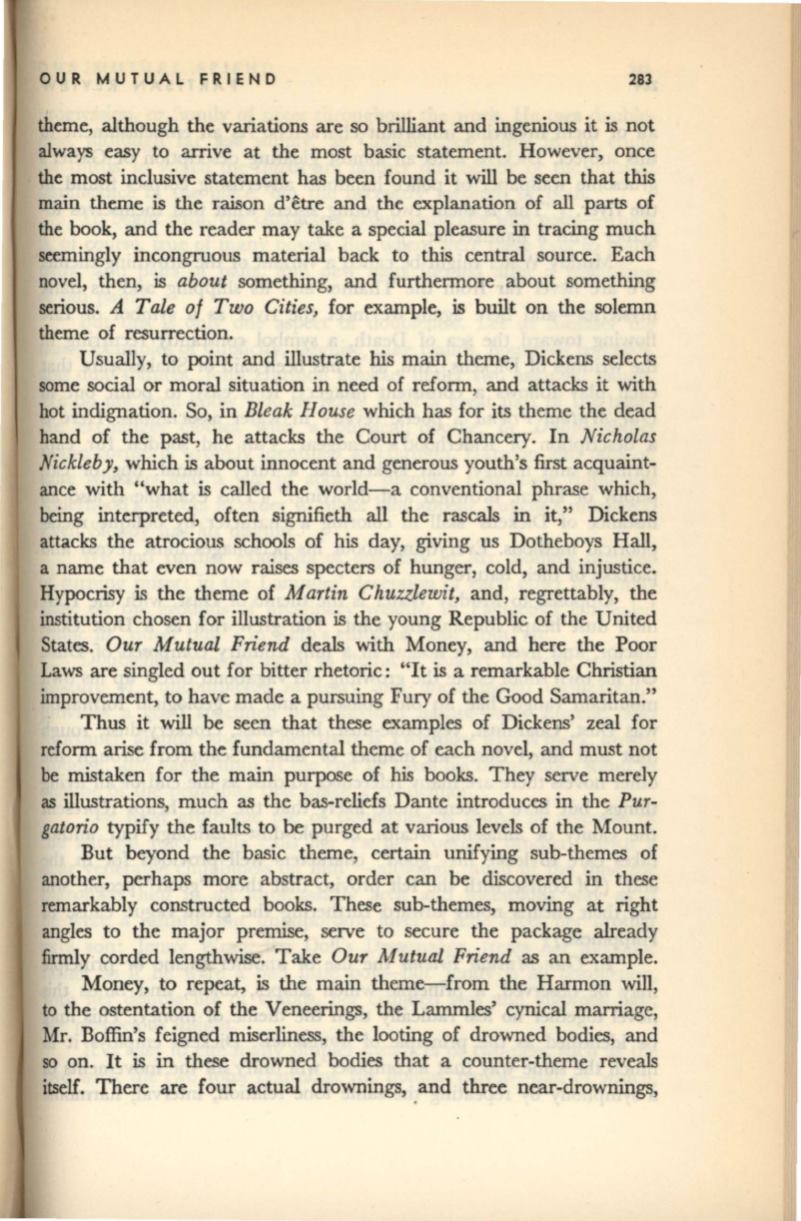
OUR MUTUAL FRIEND
283
theme, although the variations are so brilliant and ingenious it is not
always easy to arrive at the most basic statement. However, once
the most inclusive statement has been found it
will
be seen that
this
main theme
is
the raison d'etre and the explanation of
all
parts of
the book, and the reader may take a special pleasure in tracing much
seemingly incongruous material back to this central source. Each
novel, then, is
about
something, and furthermore about something
serious.
A Tale of Two Cities,
for example,
is
built on the solemn
theme of resurrection.
Usually, to point and illustrate his main theme, Dickens selects
some social or moral situation in need of reform, and attacks it with
hot indignation. So, in
Bleak House
which has for its theme the dead
hand of the past, he attacks the Court of Chancery. In
Nicholas
Nickleb
y,
which is about innocent and generous youth's first acquaint–
ance with "what is called the world-a conventional phrase which,
being interpreted, often signifieth all the rascals in it," Dickens
attacks the atrocious schools of his day, giving us Dotheboys Hall,
a name that even now raises specters of hunger, cold, and injustice.
Hypocrisy is the theme of
Martin Chuzzlewit,
and, regrettably, the
institution chosen for illustration is the young Republic of the United
States.
Our Mutual Friend
deals with Money, and here the Poor
Laws are singled out for bitter rhetoric:
"It
is a remarkable Christian
improvement, to have made a pursuing Fury of the Good Samaritan."
Thus it will be seen that these examples of Dickens' zeal for
reform arise from the fundamental theme of each novel, and must not
be mistaken for the main purpose of
his
books. They serve merely
as
illustrations, much as the bas-reliefs Dante introduces in the
Pur–
gatorio
typify the faults to be purged at various levels of the Mount.
But beyond the basic theme, certain unifying sub-themes of
another, perhaps more abstract, order can be discovered in these
remarkably constructed books. These sub-themes, moving at right
angles to the major premise, serve to secure the package already
firmly corded lengthwise. Take
Our Mutual Friend
as an example.
Money, to repeat, is the main theme-from the Harmon will,
to the ostentation of the Veneerings, the Lammles' cynical marriage,
Mr. Boffin's feigned miserliness, the looting of drowned bodies, and
so on.
It
is in these drowned bodies that a counter-theme reveals
itself. There are four actual drownings, and three near-drownings,


